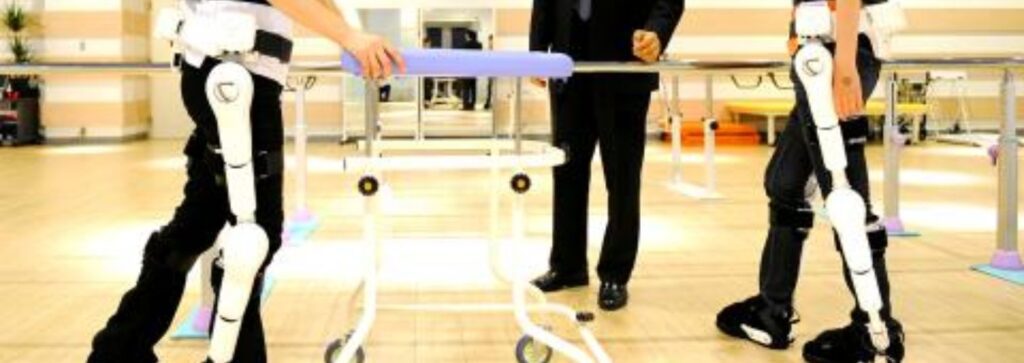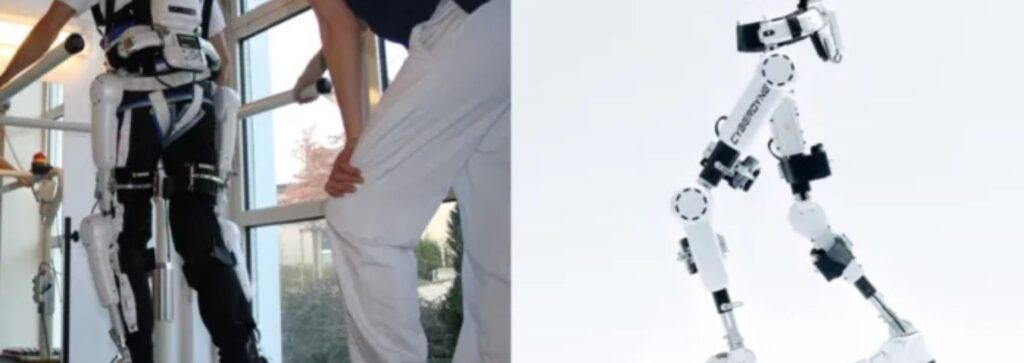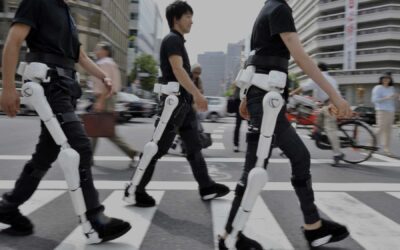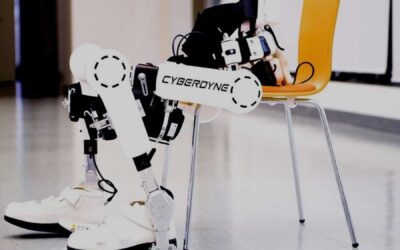The Hybrid Assistive Limb helps with voluntary control of the knee and hip joint motion as a wearable robot suit. It detects the bioelectric signals produced by patients’ muscle activities and the force-pressure signals resulting from patients’ weight shifts.
Wearable cyborg Hybrid Assistive Limb (HAL) treatment from Cyberdyne enhances ambulatory function in patients with slowly progressive rare neuromuscular diseases.
Cybernics Treatment

The use of Cybernics Treatment involves the utilisation of HAL to restore the function of the individual wearing it. This treatment is focused on addressing spinal cord injury, stroke, and neuromuscular diseases.
When an individual attempts to move their body, a signal is sent from the brain to the muscles through the nerves based on the intended movement. During this process, faint bioelectric potential signals are emitted to the body’s surface. HAL identifies the wearer’s bioelectric potential signal using a sensor attached to the skin and translates it into action. The brain transmits nerve impulses to the leg muscles, which are then picked up by sensors on the patient’s skin.
The transmission of voluntary command signals from the human brain to the musculoskeletal system via the spinal cord and peripheral nerves is essential for promoting functional improvement through Cybernics treatment. Equally important is the return of feedback from the sensation of actual movement to the human brain.
The “Wearable Cyborg™” utilises advanced treatment technology to enhance human brain-nerve-musculoskeletal functions by harnessing the body’s inherent self-healing capabilities, thus enabling functional improvement and regeneration. The “Wearable Cyborg™” is a groundbreaking treatment technology that enhances the functions of the human brain, nerves, and musculoskeletal system by triggering the body’s natural self-healing ability.
HAL’S Motion Principle
The robotic suit, HAL, utilises the patient’s volition to move the limbs:
- Command signals are generated
The brain produces and sends signals to muscles needed for movement via nerves.
- Receiving the signals, the muscle move
The muscle generates power by contracting when it receives the correct command signal from the brain via the nerves.
- HAL Reads Signals
The brain sends signals to muscles, and these signals leak onto the skin surface as faint bio-electric signals.
- HAL Moves as The Wearer Intends
The power units at each joint are regulated by HAL according to bio-electrical signals [BES], enabling the wearer to execute desired movements through voluntary commands.
- The Brain Learns Motions
Once HAL has effectively aided the desired motion, the sensation is relayed to the brain. Engaging these neural pathways for purposeful movement with physical input to the brain results in enhanced capability for the user to walk independently.
Recovery from Robots

Rehabilitation robots have vast potential in the field of physical therapy. Our sensing technology is relied upon by leading rehabilitation clinics to make daily strides in rehabilitation. Find out how you can harness ‘Cyberdyne technology’ to accomplish the same.
Rehabilitation robots are beneficial in physical therapy because they enhance the frequency of exercises performed by patients.
Our Patient – Anderson’s Says
I was using my hips to lift my legs while walking, instead of my knees. After undergoing 3 months of rigorous therapy at Cyberdyne in Bochum, I was able to walk by lifting my knees. As a result, I can now walk for longer periods due to the improvement in my walking technique. Prior to my treatment at Cyberdyne, it took me almost 4 minutes to walk 10 meters, but now I can do it in around 50 seconds. The “Wearable Cyborg™” utilises brain waves to enable individuals to improve their ambulatory function and walk.
Log onto https://rehabmodalities.com/ for more info on our neuro-robotic rehabilitation technology that benefits patients.



